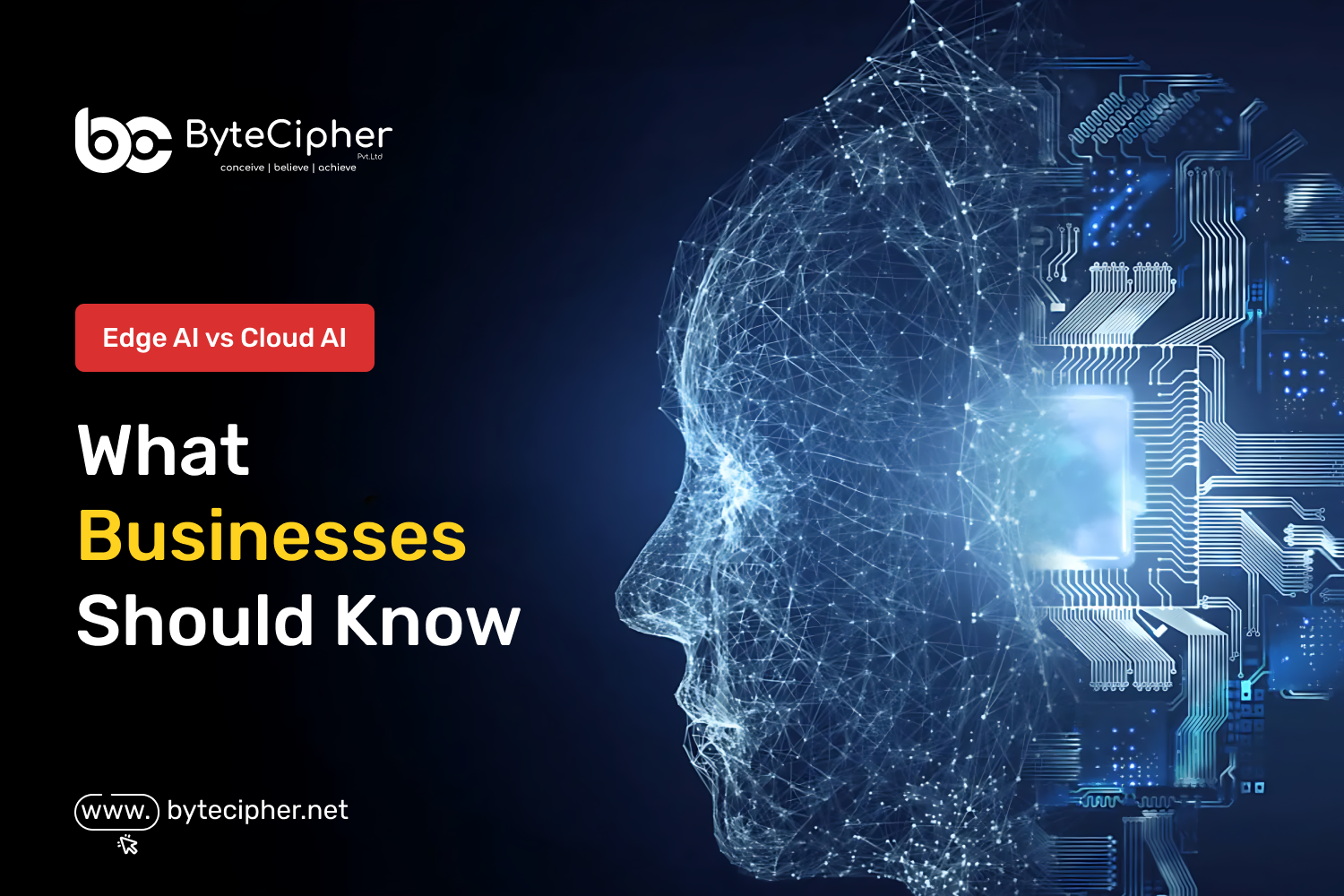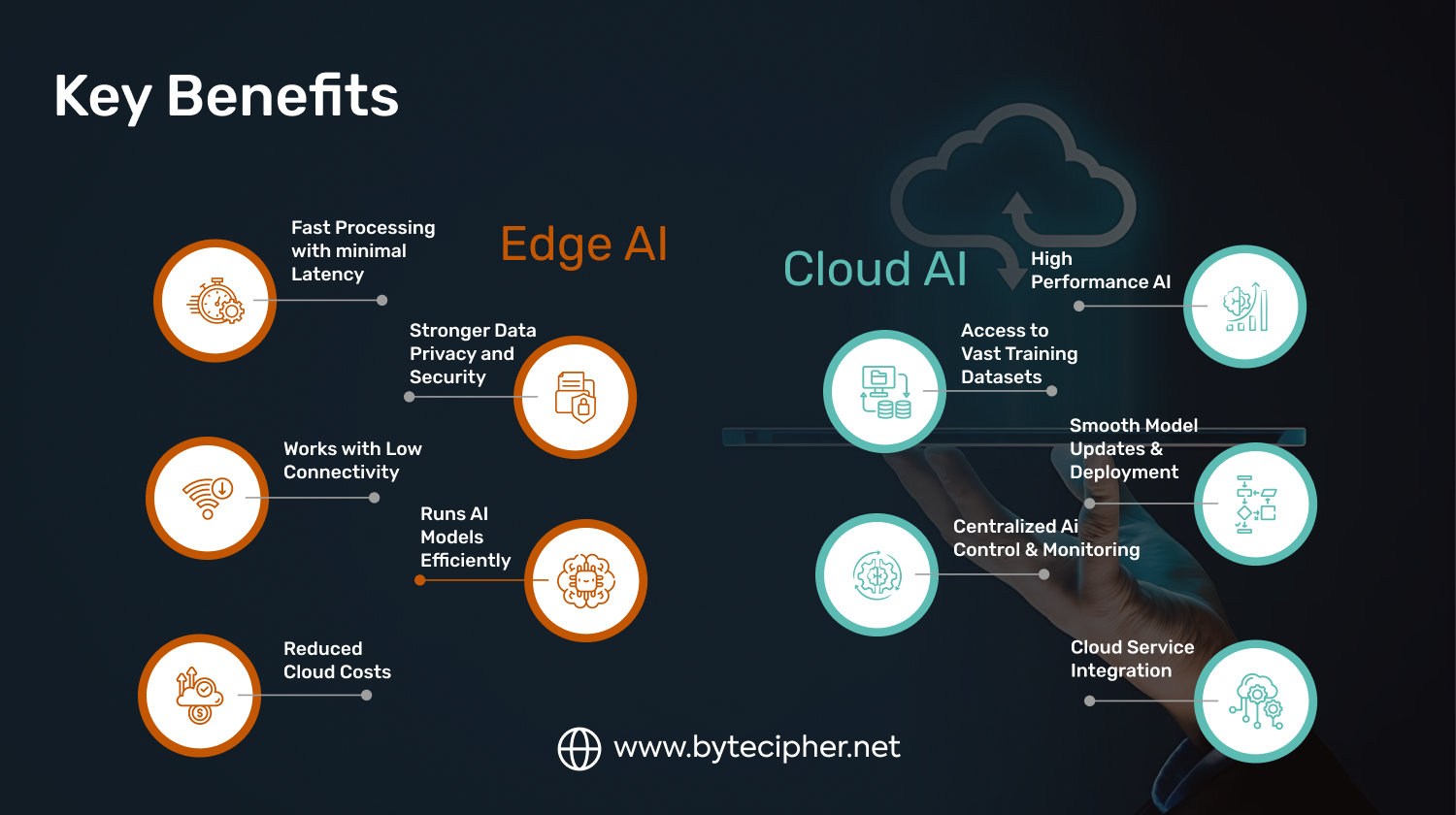
Artificial intelligence is become the cornerstone of contemporary corporate innovation, not merely a trendy tech term. However, when it comes to using AI, businesses frequently have to make a crucial decision: Should intelligence reside in the boundless potential of the cloud (Cloud AI) or closer to the action (Edge AI)?
In addition to performance, this choice affects cost, competitiveness, security, and customer experience.
The Significance of the Discussion
Think of Edge AI as the sprinter: quick, nimble, and built to make snap judgments. The strategist, on the other hand, is Cloud AI; it is strong, analytical, and designed to see the big picture.
Businesses in today’s digital environment have to choose between speed, scale, or the ideal combination of the two.
Edge AI – The Origin of Intelligence
Edge AI handles data at the point of generation, whether it be from a wearable, factory sensor, or self-driving car, rather than sending it all to the cloud.
Why business matters:
-
Consumers anticipate prompt replies, such as immediate fraud warnings.
-
More robust data privacy is required by regulations.
-
In many places, connectivity is erratic, thus offline intelligence is essential.
Example: Without awaiting cloud clearance, a medical wearable that can identify abnormal heartbeats and notify clinicians immediately.
Scalable Intelligence using Cloud AI
Big data and teamwork are key components of cloud AI. It can learn from millions of users and train enormous models thanks to its almost limitless storage and processing capacity.
The importance of it for business:
-
Using centralized analytics, leaders can identify trends in international marketplaces.
-
In the absence of significant local infrastructure, teams can swiftly implement AI services.
-
The challenge of maintaining and scaling AI systems is managed by cloud providers.
Example: A massive e-commerce company that analyzes millions of transactions per day to make accurate product recommendations.
Edge AI vs Cloud AI: The Business Trade-Off
| Business Priority | Edge AI Advantage | Cloud AI Advantage |
|---|---|---|
| Customer Experience | Instant, real-time responsiveness | Personalized experiences at scale |
| Security & Privacy | Keeps sensitive data on local devices | Centralized monitoring and compliance |
| Cost Efficiency | Saves bandwidth and cloud usage costs | Economies of scale for heavy workloads |
| Innovation Speed | Enables new IoT and mobility-driven solutions | Faster deployment of enterprise-wide AI |
| Resilience | Works offline, even with poor connectivity | Cloud backup ensures disaster recovery |
Bringing the Best of Both Worlds to the Hybrid Future
A hybrid AI strategy is being developed by forward-thinking businesses rather than picking one or the other.
- Edge AI manages decision-making in real time.
- Cloud AI oversees global analytics, model training, and deeper insights.
A smart factory, for instance, use Edge AI to identify problems with its machinery in real time while sending aggregated performance data to the cloud for predictive maintenance scheduling.
What Companies Need to Do Next
The choice between Edge AI and Cloud AI is no longer straightforward. Strategically matching AI capabilities to business objectives, consumer expectations, and compliance requirements is crucial for progressive enterprises. In order to make the best decision, businesses should concentrate on three main areas
A. Establish High-Impact Use Cases
Different kind of intellect are needed for different problems. Companies ought to start by connecting AI use cases to operational requirements:
- Environments requiring quick reactions, such driverless cars, point-of-sale fraud detection, factory quality checks, or medical monitoring devices, are perfect for Edge AI. In these situations, latency can determine whether something is safe or fails.
- On the other hand, Cloud AI is particularly good at analyzing massive amounts of data and providing strategic insights. Consider consumer personalization engines, long-term demand forecasting, or global trend research. Large datasets, pooled learning, and computing power that edge devices cannot match are all made available to enterprises by the cloud.
Companies can minimize resource waste and increase return on investment by dividing projects into “real-time operational” and “strategic and analytical” categories.
B. From Day One, Put Compliance & Security First
The way that data can be processed, shared, and stored is changing due to regulatory frameworks like GDPR, HIPAA, PCI-DSS, and developing AI ethics rules. Businesses have to carefully choose whether to send sensitive data to the cloud or leave it on the edge device.
- Because Edge AI keeps more data locally, it minimizes exposure, which can improve consumer trust and reduce compliance concerns.
- Although Cloud AI centralizes control, companies still need to make sure that strict encryption, access controls, and third-party provider audits are in place.
Easing adoption and preventing expensive legal or reputational setbacks are two benefits of making security and compliance a design element rather than an afterthought.
C. Use a Hybrid Approach to AI
Combining the speed of the edge with the size of the cloud is the key to the future of AI, not picking just one route. Businesses can use hybrid models to:
- Run real-time, mission-critical AI on edge devices to maintain performance even in the event of low connectivity.
- Retrain models, do global optimization, and conduct long-term analysis by pushing data back to the cloud.
- Create scalable, adaptable infrastructures that can change to meet changing customer needs, legal requirements, and new developments in technology like 5G and quantum computing.
Businesses who adopt this dual approach will not only secure their operations for the future, but they will also maintain an advantage over rivals who are still arguing over edge vs. cloud.

The Reasons Behind Businesses Using Edge AI
Edge AI adoption is being driven by the need for real-time insights, quicker decision-making, and improved security as enterprises speed their digital transformation. Organizations are now delivering intelligence directly to devices and local surroundings rather than depending only on cloud servers. This change ushers in a new era of industry-wide innovation.
1. Making decisions in real time
In sectors like manufacturing, healthcare, and self-driving cars, milliseconds are crucial. By analyzing data locally rather than requiring round trips to the cloud, edge AI allows for instantaneous replies. In order to avoid collisions or save lives, for instance, self-driving cars and medical monitoring gadgets depend on instantaneous decision-making.
2. Better Security & Privacy for Data
The handling of sensitive data has been reexamined by enterprises due to data breaches and compliance regulations such as GDPR and HIPAA. Because Edge AI keeps data on-device, it lowers exposure risks and complies with privacy laws. Edge AI is being especially used by government organizations, financial institutions, and healthcare providers for safe local processing.
3. Less Reliance on the Network and Latency
For seamless operation, cloud AI needs fast internet. However, Edge AI makes sure that activities continue offline or with little bandwidth in places with intermittent or inadequate connectivity, such as remote industrial sites, oil rigs, or rural healthcare facilities.
4. Data processing cost effectiveness
The cost of sending large amounts of data to the cloud is high. Only essential data is sent to the cloud for storage or more in-depth analysis when Edge AI helps businesses filter and analyze important insights locally. This maximizes cloud utilization and lowers bandwidth expenses.
5. Scalable Smart Devices & IoT
From industrial sensors to smart cameras, the proliferation of IoT devices necessitates effective data management. By enabling instantaneous information analysis, Edge AI lessens reliance on cloud resources. Edge AI is being used in smart cities, smart factories, and linked retail establishments to enhance automation and customer satisfaction.
6. Applications Particular to a Sector
- Healthcare: Predictive diagnostics, real-time patient monitoring.
- Manufacturing: Quality assurance and predictive maintenance.
- Retail: Inventory control, customized consumer experiences.
- Smart cities: energy optimization and traffic control.
- Security and defense: monitoring, identifying threats.
The Interaction between Cloud and Edge AI
1. Gathering and Preliminary Processing of Data at the Edge
IoT gateways, cameras, and industrial sensors are examples of edge AI devices that act as the first line of defense. They do this locally, selecting what is relevant and taking immediate action when necessary, rather than transmitting raw data to the cloud. In situations where every millisecond matters, this local processing improves latency, lessens reliance on continuous connectivity, and permits real-time decision-making. For instance, it is possible to regulate suspicious activity, monitor patient vitals, and detect abnormal equipment behavior all at the edge without any delays.
2. More Comprehensive Cloud Analytics
The edge is great at quick reactions, while the cloud is made for more complex intelligence. Tasks like training sophisticated machine learning models, running simulations, and evaluating aggregated data gathered from several devices require a significant amount of processing power, which cloud AI offers. Businesses are able to spot trends, acquire global insights, and consistently raise the accuracy of AI thanks to this centralized method. It would be difficult to process and learn from the massive datasets produced by millions of linked devices without the cloud.
3. Model Updates & Ongoing Education
Cloud computing is essential to enabling AI’s ability to learn continuously. Cloud systems use massive information to retrain and refine AI models, keeping them current against evolving surroundings or new threats. These improved models are then returned to edge devices after training, allowing them to carry out more intelligent real-time activities. Through this cycle of learning, updating, and redeploying, intelligence continuously changes and adapts, making AI responsive and prepared for the future.
4. Scalability and Worldwide Perspectives
When combined, edge and cloud AI provide the ideal mix between local effectiveness and global intelligence. Fast, private, and context-aware judgments are handled by edge systems near the data source, whereas cloud systems combine data from various devices and locations to provide the overall picture. This hybrid strategy guarantees that companies can plan strategically at the global level and respond swiftly at the local level. It turns dispersed activities into unified ecosystems, which is crucial for industries like global supply chains, smart cities, connected cars, and healthcare.
5. Cost-effective & Resilient Operations
The cooperation between cloud and edge Strong and economical infrastructure is produced by AI. Organizations can lower bandwidth requirements and save money by processing vital data at the edge rather than sending massive amounts of unprocessed data to the cloud. In addition, the cloud offers multi-device coordination, scalable storage, and sophisticated analytics, guaranteeing system continuity even in the event of a disruption to one component. In addition to saving money, this equilibrium provides resilience, enabling companies to continue operating normally while quickly adjusting to new situations.
Final Thoughts
The future is about Edge + Cloud AI collaborating, not just Edge vs. Cloud AI. Companies that find the ideal mix will be able to operate more quickly, intelligently, and securely.
To put it briefly:
- When speed and privacy are most important, use Edge AI.
- When intelligence and scale are important, use cloud AI.
- For an AI strategy that is future-proof, combine the two.


